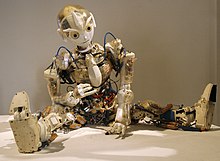Humanoid robot

A humanoid robot is a highly developed machine being, more precisely a robot whose construction is modeled on the human form . The positions of the joints and the motion sequences of a humanoid robot are often inspired by the human joint positions and motion sequences. Among other things, a humanoid robot usually walks on two legs. A form of the humanoid robot that is particularly similar to humans in terms of appearance and behavior is the android .
history
The idea of building an artificial human is old. The Greek mythology says that the blacksmith god Hephaestus u. a. have built human-like machine beings. In 1495 Leonardo da Vinci sketched a simple machine that looked like a soldier in armor. In 1738 Jacques de Vaucanson built a mechanical flute player. Up to this point in time, such mechanical, human-like machines were called automatons.
The term robot was coined by Karel Čapek , a Czech writer, in 1921 in his play RUR (Rossum's Universal Robots), which is about artificial people. The term robot is derived from the Slavic word rabota , which means work. In 1927 Fritz Lang created a machine man with a female appearance in his film Metropolis , who was given the shape of a deceptively human-like android in the course of the film.
A prototypical realization, the humanoid robot Elektro , was presented by the Westinghouse company at the 1939 World's Fair in New York.
In 1962 the Viennese Claus Scholz constructed a humanoid robot, the MM 7, which was able to implement very complex sequences of movements (opening doors, sweeping the floor or pouring drinks from a bottle into a glass). However, it did not work completely autonomously, rather it was dependent on an external unit for both power supply and control commands, to which it was connected via cables. The MM 7 has been preserved and is housed in the Technical Museum Vienna . One of the biggest problems that Scholz had to struggle with was locomotion, which could not be satisfactorily solved with the MM 7 and its successor MM 9. Finding a promising approach here was reserved for the next generation of researchers.
In 1970, Miomir Vukobratović proposed the zero-moment-point principle. With the help of this principle, the conditions for statically stable running could be met. In 1973 Waseda University built the Wabot-1 and began a long-term research program. In 1980 the MIT Leglab was founded. In 1984 the Wabot-2 played an electric organ. Since 1986 Honda worked on the E-series, which later became the P-series and ASIMO . In parallel, passive dynamic runners have been developed since around 1990 , using a newer approach to running. Robots have been walking, walking and running faster and more flexibly since around 2004.
Research and Development
The development of humanoid robots is based on two main motives:
Artificial intelligence
Today, many scientists assume that the construction of a functional humanoid robot is the basis for the creation of a human-like, artificial intelligence (AI). According to this view, AI cannot simply be programmed, but results from a learning process. So a self-learning algorithm would have to be implemented in the device. This point of view is based on observations from learning psychology. The robot with AI should actively participate in human social life and learn through observation , interaction and communication . Communication is based on an underlying motivation on both sides, which is at least initially similar to that in the parent-child relationship. The robot's AI can only develop optimally if it is recognized as an equivalent being in its minimum scope of functions. To do this, he must have a human shape, mobility and sensors . The current goal is therefore a high-quality technical copy of human physiology. This particular technological challenge means that there are separate research groups for complex sub-aspects that work together. Examples are the Leg Laboratory at the Massachusetts Institute of Technology , the humanoid robot project COG and the AI project Kismet .
Multifunctional working machine
Cost-intensive commercial or state-sponsored humanoid robot projects show high expectations of the future profitability of such systems. The human habitat (buildings, means of transport, tools or devices) is economically oriented for reasons of cost and is particularly oriented towards human physiology. A number of adaptive, multifunctional humanoid robots produced in series makes the production, sale and maintenance of many special robots unnecessary. In particular, activities that consist of several complicated operations can be carried out easily. A multifunctional helper should stand by the people who save them work or time in their environment or provide entertainment. Japan, like Germany, has a strong aging of the population. It is hoped that the consistent use of these all-rounders will support seniors in everyday life or relieve the burden on nursing staff. In order to increase the acceptance of robots in society, the Socially Intelligent Machines Lab of the Georgia Institute of Technology is researching the social skills of humanoid robots.
Current state of development
So far, hardly any development has reached market maturity; it is more a question of studies and marketing means. Current skills include:
- walking, running, hopping on one leg, dancing, walking around moving obstacles, climbing stairs, walking in impassable terrain, opening the door, balancing violent bumps from the outside, getting up again after falling
- Push the tray trolley, receive, transport, hand over, serve
- Sign language
- Playing the trumpet, playing the violin, playing music in a band
- Ride a bike, catch and throw the ball
- Pouring drinks, loading and unloading the dishwasher, doing household chores such as B. Cooking, wiping windows and sweeping the floor, carrying loads, picking up boxes and putting them away
Commercial projects humanoid robots
- ASIMO ( Honda ) - for rent
- Atlas of Boston Dynamics
- HOAP -1 and -2 ( Fujitsu ) - a humanoid robot series, which is also sold commercially for research purposes
- Toyota Robots ( Toyota ) - entertainment robots
- Qrio ( Sony ) - further development discontinued in March 2006
- Wakamaru ( Mitsubishi ) - on sale
- Ri-man , Japan
- REEM-A and REEM-B , both from Pal Technology
- Pepper on sale since 2015
- Boston Dynamics' PETMAN Prototype of a humanoid robot used in the testing of protective suits for the US military
- Nao , toy robot from Aldebaran Robotics
- Alpha 1S from UBTECH
Projects humanoid robots in AI research
- Cronos, Laboratory for Artificial Intelligence University of Zurich as part of the ECCE Robot project of the EU
- RobotCub , Italian / British university consortium
- COG, Kismet , Massachusetts Institute of Technology
- ERATO Synergistic Robotics, Osaka University
- HUBO Labs at KAIST in South Korea build and research life-size humanoid robots
In Germany, the following - mostly university - institutions are researching with humanoid robots:
- Rheinische Friedrich-Wilhelms-Universität Bonn ( NimbRo )
- Free University of Berlin ( FUmanoids )
- Beuth University of Applied Sciences Berlin ( Neurorobotics research laboratory , Myon robot )
- Technical University Berlin ( DAI Labor )
- Technical University of Darmstadt ( Darmstadt Dribblers )
- University of Bremen ( B-Human )
- Technical University of Dortmund ( DoH! Bots )
- University of the Federal Armed Forces Munich ( HERMES )
- Karlsruhe Institute of Technology ( ARMAR III )
- Technical University of Munich ( Johnnie , Lola )
- Institute for Robotics and Mechatronics of the German Aerospace Center ( Rollin 'Justin , TORO )
courses
The Beuth University of Applied Sciences Berlin offers the so far only nationwide course on humanoid robotics. In addition, the topic can be deepened in higher-level courses such as robotics , automation and control technology from various institutions. In an international context, for example, an Imperial College London offers a corresponding master’s degree.
Web links
- Boris Hänßler: The humanoids are coming . In: Spectrum of Science , October 11, 2013.
Individual evidence
- ^ Socially Intelligent Machines Lab
- ↑ Asimo running on YouTube
- ↑ Robots dancing on YouTube
- ↑ Robot runs around moving obstacles on YouTube
- ↑ DARPA Robot Masters Stairs on YouTube
- ↑ a b Atlas, The Next Generation on YouTube
- ↑ new version amazing robot asimo on YouTube
- ↑ All-New ASIMO Humanoid Robot - Sign Language on YouTube
- ↑ Robot plays the trumpet on YouTube
- ^ Robot violinist on YouTube
- ↑ Robot Music Quartet on YouTube
- ↑ Robot rides a bike on YouTube
- ↑ Playing Catch and Juggling with a Humanoid Robot on YouTube
- ↑ Honda's all-new ASIMO Prepares and Serves Refreshments on YouTube
- ↑ see Armar 3
- ↑ Robots for the household
- ↑ Robot sweeps the floor and wipes window pane on YouTube
- ^ Atlas, The Next Generation
- ↑ Humanoid Robot HOAP-1 ( Memento of the original from December 21, 2007 in the Internet Archive ) Info: The archive link was inserted automatically and has not yet been checked. Please check the original and archive link according to the instructions and then remove this notice. and HOAP-2 ( Memento of the original from September 11, 2007 in the Internet Archive ) Info: The archive link was inserted automatically and has not yet been checked. Please check the original and archive link according to the instructions and then remove this notice. (English) - a humanoid robot series from Fujitsu
- ↑ spiegel.de: Toyota's Fiedel-Robbi
- ↑ bostondynamics.com
- ↑ Mobile humanoid "Rollin 'Justin" on the DLR website of the Institute for Robotics and Mechatronics
- ↑ TORO on the DLR website of the Institute for Robotics and Mechatronics
- ↑ Catherine Juschkat: study. For the first time "Humanoid Robotics" offered as a course of study. In: Electrical engineering automation. Vogel Communications Group GmbH & Co. KG, Ines Stolz, April 13, 2018, accessed on October 29, 2019 .
- ↑ Nadine Emmerich: Humanoid Robotics course. Studying robots. In: ZDF.de. Second German Television (ZDF), August 18, 2018, accessed on October 29, 2019 .
- ↑ MSc Human and Biological Robotics. In: Imperial College London. Department of Bioengineering. Retrieved October 29, 2019 .



